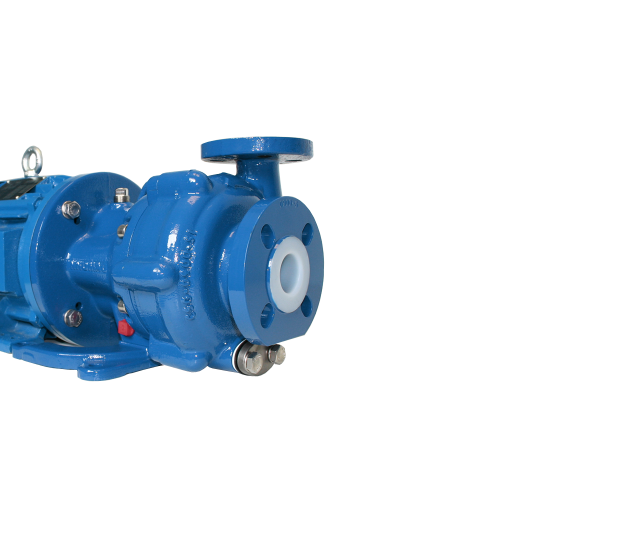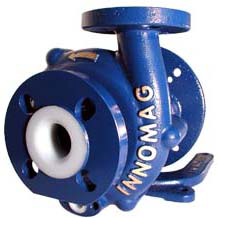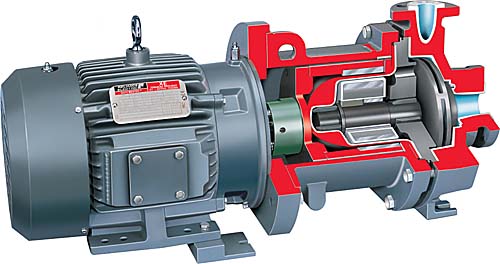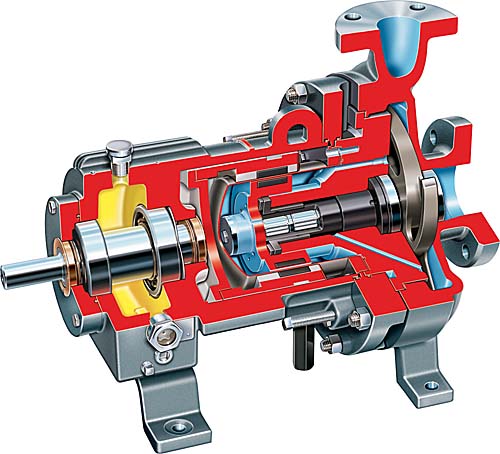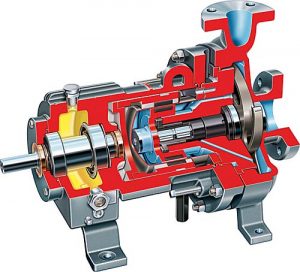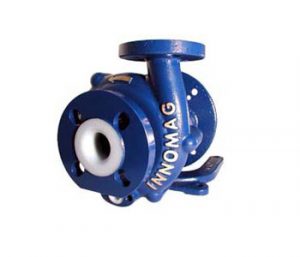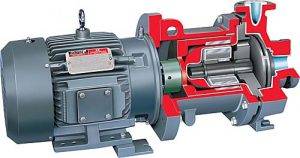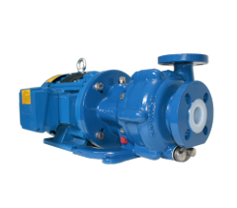Magnetic Drive Pump
A magnetic drive pump is a sealless pump that uses a magnet drive system which eliminates a conventional shaft seal.
What are the components of a Magnetic Drive Pump?
How do magnetic drive pumps work?
Magnetic Drive Pumps work by a synchronist Mag drive system due to the attraction of opposite magnetic poles, one set of magnets sits outside the pump whilst the other is present in the liquid. These magnets are separated by a pressure boundary otherwise known as a containment shell or shroud. The exterior magnet is connected to the driver i.e. motor whilst the interior magnet is connected to the impeller. As the motor shaft rotates the magnetic attraction forces the interior magnet to rotate which in turn causes the impeller to rotate thereby pumping the fluid.
How do you prime a magnetic drive pump?
A side channel Mag drive pump has the ability to self-prime as well as the gear pump and screw pump. The suction piping should be arranged in such a way that the liquid is retained in the pump to facilitate re-priming.
What is magnetic drive coupling?
A magnetic drive coupling is defined as a device which transmits power from a driver to a driven machine and the magnets are used in place of a conventional coupling for a close coupled pump. However, for a long-coupled pump or frame mounted pump, a conventional coupling is used in addition to the magnets.
Are Mag drive pumps a type of Centrifugal pumps?
The most common type of Mag drive pump is Centrifugal pumps however, in theory, Magnetic drive technology can be adapted to any type of pump i.e. side channel pump, multi stage pump, gear pumps and screw pumps.
Would you use a Magnetic drive pump for the pumping of alkali and caustic chemicals?
The primary reason for using a Magnetic drive pump for the pumping of alkali and caustic chemicals is to prevent fugitive emissions i.e. leaks. In several cases, the liquid itself and the vapours are harmful to health. If a mechanical seal was to fail, often quite catastrophically, this would result in a safety hazard and incident on site. Also some fluids crystallise on contact with air which leads to a shortened mechanical seal life which is eliminated by using a sealless pump.
What are the typical applications in which you would use a Magnetic Drive pump?
The typical applications in which you would use a Mag drive pump are chemical transfer, tank unloading or in heat transfer fluid. Mag drive pumps can handle temperatures from -100°C to +400°C. Other applications where you might use a Mag drive pump is when the product is very expensive, and you want to mitigate the risk of losing any product.
What are the pros and cons of a Magnetic drive pump?
Traditionally, Mag drive pumps would be used on clean fluids with little or no solids.
The main pro’s or advantages of a Mag drive pump are;
- They are Leak-free, if selected and operated correctly
- They do not require monitoring in comparison to a pump with any type of mechanical seal
- Can last up to 20 years of service without requiring an overhaul
- They do no require cooling and generally they do not require time consuming alignment as they are close coupled therefore the alignment of the pump and motor is unaffected by temperature swings.
The main cons’s or disadvantages of a Mag drive pump are;
- Many Mag drive pumps application are limited by the size, type (hard/soft) and % of solids in the package or where dry running is anticipated whether by accident or design. In any case, Mag drive pumps should be protected by a suitable device.
Flexachem has a range of Mag drive pumps in our portfolio with outstanding capabilities as well as the option of dry running product lubricate bearings which permit limited dry running in the event of primary detection device failure.
What is the difference between NNOMAG pump and the U-Mag drive pump?
The U-Mag drive pump’s material of construction is PTFE or high purity PFA. It has a tangential discharge rather than a centerline discharge design so does not comply to any of the pump dimensional standards. It doesn’t have the same feature as the INNOMAG – DLC bearing. The U-Mag drive pump has a very limited solid handling capability and hydraulic range. It is however considered more economical and lower cost than the INNOMAG pump.
The INNOMAG pump’s material of construction is PTFE. It has outstanding solids handling capability. It offers a dry running bearings option. It has wide hydraulic coverage and is available in accordance with ANSI and ISO dimensional standards. It is also available in ANSI 300Ib option – high pressure capability.
What is the difference between high pressure and low flow Mag Drive Pumps?
A high-pressure Mag drive pump has 2 definitions – a) its ability to generate a high pressure either by a special impeller design, multistage design or high-speed design or b) higher pressure rating design i.e. ANSI 150 vs ANSI 300 (PN16 VS PN40).
A low flow characteristic may be achieved by an alternate impeller design i.e. side channel barske. It may also be achieved by integral orifice as in the case of the INNOMAG TB pump.
Which Mag drive pumps does Flexachem supply?
Flexachem supply polymer lined Mag drive pumps, metallic and non-metallic mag drive pumps.
Why not contact our Pump Expert team to discuss a particular application you have in mind.
Contact our Pump Specialist Team:
Phil Soltan (External) – mob: 086 185 3782
Internal Team
Adrian McSweeney – tel: 021 461 7212
Paul-Fox Morris – tel: 021 461 7231
Una Long (Pump & Service Support) – tel: 021 431 7200
Tel: 021 4617 200
Products
-
INNOMAG U-MAG Drive Pump
View Product -
Innomag TB-Mag Drive Pump
View Product -
ANSI, Overhung, Non-Metallic, Magnetic Drive Pump
View Product -
Guardian ANSI Overhung Magnetic Drive Pump
View Product

